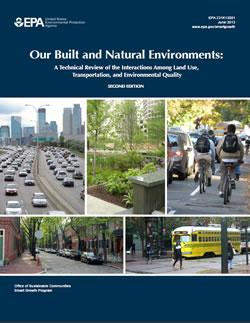
A Technical Review of the Interactions Between Land Use, Transportation, and Environmental Quality (2nd Edition)
Decisions about how and where we build our communities have significant impacts on the natural environment and on human health. Cities, regions, states, and the private sector need information about the environmental effects of their land use and transportation decisions to mitigate growth-related environmental impacts and to improve community quality of life and human health. In 2001, EPA published Our Built and Natural Environments: A Technical Review of the Interactions Between Land Use, Transportation, and Environmental Quality to show how development patterns affect the environment and human health. Since then, research has continued to clarify and better explain these connections. To capture this research, EPA revised and updated the report in 2013, incorporating key findings from hundreds of studies.
The second edition of Our Built and Natural Environments:
- Discusses the status of and trends in land use, development, and transportation and their environmental implications. Findings include:1
- The U.S. population is projected to grow 42 percent between 2010 and 2050, from 310 million to 439 million (Vincent and Velkoff 2010).
- While the population roughly doubled between 1950 and 2011 (U.S. Census Bureau), vehicle travel during this same period increased nearly sixfold (Federal Highway Administration 2010 and 2012). However, evidence suggests that the growth of vehicle travel might be slowing in recent years.
- Virtually every metropolitan region in the United States has expanded substantially in land area since 1950—including regions that lost population during that time (U.S. Census Bureau).
- Articulates the current understanding of the relationship between the built environment and the quality of air, water, land resources, habitat, and human health. Findings include:
- Biodiversity: For nearly all plants and animals, species diversity declines with increases in the amount of impervious surface, road density, time since development, human population density, and building density (Pickett et al. 2011).
- Water: Development in watersheds reduces the quantity, quality, and diversity of stream habitat for aquatic life (Booth and Bledsoe 2009). As water is polluted and degraded, it can become unfit for drinking, swimming, fishing, and other uses.
- Air: More than 38 percent of national carbon monoxide emissions and 38 percent of nitrogen oxide emissions come from highway vehicles. Stationary sources like power plants that provide energy to homes, offices, and industries are also major sources of pollution (EPA 2012).
- Climate Change: Greenhouse gas emissions from the transportation sector increased 19 percent between 1990 and 2010, due primarily to the increase in vehicle travel but partially offset by a slight increase in average fuel economy as older vehicles were removed from the roads (EPA 2012).
- Health: While data are lacking to determine whether the built environment determines levels of physical activity and/or obesity, nearly 90 percent of studies found a positive association (Ferdinand et al. 2012), suggesting that the built environment is one of the many factors that could play a role in how much people exercise and levels of obesity.
- Safety: Car crashes are the third leading cause of death in terms of years of life lost given the young age of so many car crash victims and the number of years they would have been expected to live if they had not died in a car crash. Only cancer and heart disease are responsible for more years of life lost (Subramanian 2011).
- Provides evidence that certain kinds of land use and transportation strategies can reduce the environmental and human health impacts of development. Findings include:
- Development in and adjacent to already-developed areas can help protect natural resources like wetlands, streams, coastlines, and critical habitat.
- Residents of transit-oriented developments are two to five times more likely to use transit for commuting and non-work trips than others living in the same region (Arrington and Cervero 2008).
- In general, the greater the population density of an area, the less the area's residents tend to drive (Transportation Research Board of the National Academies 2003). Doubling residential density across a metropolitan region could reduce household vehicle travel by between 5 and 12 percent (National Research Council of the National Academies, Driving and the Built Environment 2009).
- Communities with streets designed for the safety of all users can encourage walking and biking and help people lead healthier lifestyles (Giles et al. 2011).
- A review of green building retrofits of commercial buildings around the world found energy savings of 50 to 70 percent (Harvey 2009).
- Water-efficient household appliances and fixtures can yield significant water savings, and careful selection of construction materials can conserve natural resources and improve indoor air quality. Site-scale green infrastructure can also reduce development's impacts on water quality.
EPA's Smart Growth Program has many resources that give more information on development strategies that reduce environmental and health impacts while improving quality of life, providing more housing and transportation options, and achieving other community goals. See Smart Growth Publications and Smart Growth Topics for links to these resources.
1Full citations for all of the findings are in Our Built and Natural Environments.
You will need Adobe Reader to view some of the files on this page. See EPA’s About PDF page to learn more.